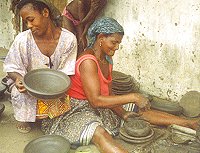 Pottery
Traditional pottery in Ghana is simple and functional.
Glaze is not common and the color of the pot depends
largely on the type of clay used, although some pots are
black from the smoke created during firing. Pots are
still used to prepare, cook, and store food. Perhaps the
most functional is the grinding bowl which is shallow
with ridges on the inside. Food is ground with a small
wooden pestle. Pots are low fired, therefore fragile, but
inexpensive and for sale in every market and often on the
roadside. Traditionally pottery is made by women, but
many men are contemporary potters with many design
departures from the women's pots. (for more on pottery,
see an article Ellie wrote for
Studio Potter). Pottery
Traditional pottery in Ghana is simple and functional.
Glaze is not common and the color of the pot depends
largely on the type of clay used, although some pots are
black from the smoke created during firing. Pots are
still used to prepare, cook, and store food. Perhaps the
most functional is the grinding bowl which is shallow
with ridges on the inside. Food is ground with a small
wooden pestle. Pots are low fired, therefore fragile, but
inexpensive and for sale in every market and often on the
roadside. Traditionally pottery is made by women, but
many men are contemporary potters with many design
departures from the women's pots. (for more on pottery,
see an article Ellie wrote for
Studio Potter).Adinkra
Adinkra is unique to Ghana. Designs are carved into a
piece of gourd, dipped in a 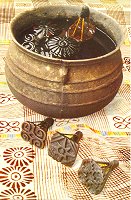 black tar like substance and stamped onto
cotton cloth. The designs have meaning to those who can
interpret them and traditionally Adinkra, made by men,
was stamped on black cloth and worn to funerals by men.
Now, Adinkra comes in many colors, although the designs
are always black, and is worn on many occasions. It is
sometimes worn instead of Kente because of its lower
cost. black tar like substance and stamped onto
cotton cloth. The designs have meaning to those who can
interpret them and traditionally Adinkra, made by men,
was stamped on black cloth and worn to funerals by men.
Now, Adinkra comes in many colors, although the designs
are always black, and is worn on many occasions. It is
sometimes worn instead of Kente because of its lower
cost.
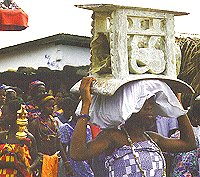 Stool
Carving There are villages in Ghana devoted just
to stool carving. It is the Ashanti belief that the stool
is the receptacle of the soul. Chiefs are enstooled and
when they die their stools are preserved with great
ceremony in shrines. Stools are also everyday items, used
instead of chairs. They range from simple and unadorned
to beautiful sculptures representing animals. Stool
Carving There are villages in Ghana devoted just
to stool carving. It is the Ashanti belief that the stool
is the receptacle of the soul. Chiefs are enstooled and
when they die their stools are preserved with great
ceremony in shrines. Stools are also everyday items, used
instead of chairs. They range from simple and unadorned
to beautiful sculptures representing animals.
Brass Castings
Ghana was once known as the Gold 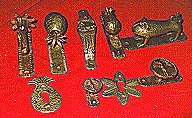 Coast and brass weights cleverly embellished
with designs were used to weigh the gold. These gold
weights were made by men using the lost wax process of
casting. Of all the crafts, this one has perhaps
translated best into contemporary usage. Because they are
attractive, inexpensive and easy to carry they are in
great demand and have been interpreted into door pulls,
boxes, small sculptures, napkin rings, etc. Coast and brass weights cleverly embellished
with designs were used to weigh the gold. These gold
weights were made by men using the lost wax process of
casting. Of all the crafts, this one has perhaps
translated best into contemporary usage. Because they are
attractive, inexpensive and easy to carry they are in
great demand and have been interpreted into door pulls,
boxes, small sculptures, napkin rings, etc.
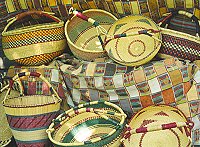 Baskets
Traditionally baskets were woven by men of the FraFra
tribe on Northern Ghana in the city of Bolgatanga. Known
as Bolga baskets they are quite beautiful and functional,
as are most crafts in Africa. There are now modern
versions of baskets that reflect the tastes of tourists
and the creativity of the basket makers who are no longer
bound by tradition. Some women have been organized into
basket making cooperatives so that they can supplement
their seasonal farming. Baskets
Traditionally baskets were woven by men of the FraFra
tribe on Northern Ghana in the city of Bolgatanga. Known
as Bolga baskets they are quite beautiful and functional,
as are most crafts in Africa. There are now modern
versions of baskets that reflect the tastes of tourists
and the creativity of the basket makers who are no longer
bound by tradition. Some women have been organized into
basket making cooperatives so that they can supplement
their seasonal farming.
Kente Cloth In
Ghana traditional weaving is done by men of the Ewe and
Ashanti tribes. 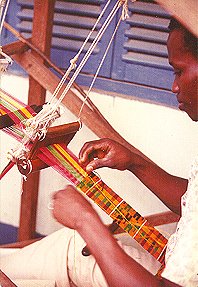 Who is
more innovative depends on your source of information.
The Ewe migrated from the north and their famous weaving
villages are in the Volta Region along the path of
migration. Ewe work is distinguished by animal, human and
symbolic patterns woven into the cloth. The Ashanti are
located in the Central Region and are known for their
traditional crafts. Ashanti cloth is usually geometric in
design. Both groups excel at weaving cloth fit for a
king, and originally Kente was only worn by kings, chiefs
or people in very prominent positions. Now, it is
available to all, but because of its expense, it is still
the cloth of prestige. Who is
more innovative depends on your source of information.
The Ewe migrated from the north and their famous weaving
villages are in the Volta Region along the path of
migration. Ewe work is distinguished by animal, human and
symbolic patterns woven into the cloth. The Ashanti are
located in the Central Region and are known for their
traditional crafts. Ashanti cloth is usually geometric in
design. Both groups excel at weaving cloth fit for a
king, and originally Kente was only worn by kings, chiefs
or people in very prominent positions. Now, it is
available to all, but because of its expense, it is still
the cloth of prestige.
 Coffins
Something that was started as a special tribute to an
uncle has turned into big business for some coffin makers
in Teshie/Nungua, a suburb of Accra. These are coffins,
although they can be considered sculptures, which are
constructed in the shape of cars (usually Mercedes),
planes, animals, etc. If you were a fisherman in life,
you can be buried and transported to the next world in a
fish. Because the cost starts around $1500 burial in one
of these clever structures is limited to a small part of
the population. Because of articles in the press,
especially National Geographic, they have become
collectors items in the western world. Coffins
Something that was started as a special tribute to an
uncle has turned into big business for some coffin makers
in Teshie/Nungua, a suburb of Accra. These are coffins,
although they can be considered sculptures, which are
constructed in the shape of cars (usually Mercedes),
planes, animals, etc. If you were a fisherman in life,
you can be buried and transported to the next world in a
fish. Because the cost starts around $1500 burial in one
of these clever structures is limited to a small part of
the population. Because of articles in the press,
especially National Geographic, they have become
collectors items in the western world.
Beads When you
ask Ghanaians where beads come from they will tell you
that they come 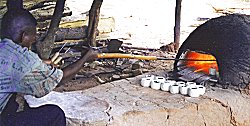 from the
ground, and indeed, many have been dug up, but the Krobo
are the most famous beadmakers in Ghana and originally
they bought their beads from traders who came from
Nigeria. Now there are several Krobo workshops where
glass beads are made in ceramic molds by firing in
woodburning kilns. Made by men, it takes several years of
apprenticeship to be able to form some of the intricate
patterns associated with African beads. For a nice photo
of Krobo beads, click here. from the
ground, and indeed, many have been dug up, but the Krobo
are the most famous beadmakers in Ghana and originally
they bought their beads from traders who came from
Nigeria. Now there are several Krobo workshops where
glass beads are made in ceramic molds by firing in
woodburning kilns. Made by men, it takes several years of
apprenticeship to be able to form some of the intricate
patterns associated with African beads. For a nice photo
of Krobo beads, click here.
|
 Pottery
Traditional pottery in Ghana is simple and functional.
Glaze is not common and the color of the pot depends
largely on the type of clay used, although some pots are
black from the smoke created during firing. Pots are
still used to prepare, cook, and store food. Perhaps the
most functional is the grinding bowl which is shallow
with ridges on the inside. Food is ground with a small
wooden pestle. Pots are low fired, therefore fragile, but
inexpensive and for sale in every market and often on the
roadside. Traditionally pottery is made by women, but
many men are contemporary potters with many design
departures from the women's pots. (for more on pottery,
see an article Ellie wrote for
Studio Potter).
Pottery
Traditional pottery in Ghana is simple and functional.
Glaze is not common and the color of the pot depends
largely on the type of clay used, although some pots are
black from the smoke created during firing. Pots are
still used to prepare, cook, and store food. Perhaps the
most functional is the grinding bowl which is shallow
with ridges on the inside. Food is ground with a small
wooden pestle. Pots are low fired, therefore fragile, but
inexpensive and for sale in every market and often on the
roadside. Traditionally pottery is made by women, but
many men are contemporary potters with many design
departures from the women's pots. (for more on pottery,
see an article Ellie wrote for
Studio Potter). black tar like substance and stamped onto
cotton cloth. The designs have meaning to those who can
interpret them and traditionally Adinkra, made by men,
was stamped on black cloth and worn to funerals by men.
Now, Adinkra comes in many colors, although the designs
are always black, and is worn on many occasions. It is
sometimes worn instead of Kente because of its lower
cost.
black tar like substance and stamped onto
cotton cloth. The designs have meaning to those who can
interpret them and traditionally Adinkra, made by men,
was stamped on black cloth and worn to funerals by men.
Now, Adinkra comes in many colors, although the designs
are always black, and is worn on many occasions. It is
sometimes worn instead of Kente because of its lower
cost.  Stool
Carving There are villages in Ghana devoted just
to stool carving. It is the Ashanti belief that the stool
is the receptacle of the soul. Chiefs are enstooled and
when they die their stools are preserved with great
ceremony in shrines. Stools are also everyday items, used
instead of chairs. They range from simple and unadorned
to beautiful sculptures representing animals.
Stool
Carving There are villages in Ghana devoted just
to stool carving. It is the Ashanti belief that the stool
is the receptacle of the soul. Chiefs are enstooled and
when they die their stools are preserved with great
ceremony in shrines. Stools are also everyday items, used
instead of chairs. They range from simple and unadorned
to beautiful sculptures representing animals.  Coast and brass weights cleverly embellished
with designs were used to weigh the gold. These gold
weights were made by men using the lost wax process of
casting. Of all the crafts, this one has perhaps
translated best into contemporary usage. Because they are
attractive, inexpensive and easy to carry they are in
great demand and have been interpreted into door pulls,
boxes, small sculptures, napkin rings, etc.
Coast and brass weights cleverly embellished
with designs were used to weigh the gold. These gold
weights were made by men using the lost wax process of
casting. Of all the crafts, this one has perhaps
translated best into contemporary usage. Because they are
attractive, inexpensive and easy to carry they are in
great demand and have been interpreted into door pulls,
boxes, small sculptures, napkin rings, etc.  Baskets
Traditionally baskets were woven by men of the FraFra
tribe on Northern Ghana in the city of Bolgatanga. Known
as Bolga baskets they are quite beautiful and functional,
as are most crafts in Africa. There are now modern
versions of baskets that reflect the tastes of tourists
and the creativity of the basket makers who are no longer
bound by tradition. Some women have been organized into
basket making cooperatives so that they can supplement
their seasonal farming.
Baskets
Traditionally baskets were woven by men of the FraFra
tribe on Northern Ghana in the city of Bolgatanga. Known
as Bolga baskets they are quite beautiful and functional,
as are most crafts in Africa. There are now modern
versions of baskets that reflect the tastes of tourists
and the creativity of the basket makers who are no longer
bound by tradition. Some women have been organized into
basket making cooperatives so that they can supplement
their seasonal farming.  Who is
more innovative depends on your source of information.
The Ewe migrated from the north and their famous weaving
villages are in the Volta Region along the path of
migration. Ewe work is distinguished by animal, human and
symbolic patterns woven into the cloth. The Ashanti are
located in the Central Region and are known for their
traditional crafts. Ashanti cloth is usually geometric in
design. Both groups excel at weaving cloth fit for a
king, and originally Kente was only worn by kings, chiefs
or people in very prominent positions. Now, it is
available to all, but because of its expense, it is still
the cloth of prestige.
Who is
more innovative depends on your source of information.
The Ewe migrated from the north and their famous weaving
villages are in the Volta Region along the path of
migration. Ewe work is distinguished by animal, human and
symbolic patterns woven into the cloth. The Ashanti are
located in the Central Region and are known for their
traditional crafts. Ashanti cloth is usually geometric in
design. Both groups excel at weaving cloth fit for a
king, and originally Kente was only worn by kings, chiefs
or people in very prominent positions. Now, it is
available to all, but because of its expense, it is still
the cloth of prestige.  Coffins
Something that was started as a special tribute to an
uncle has turned into big business for some coffin makers
in Teshie/Nungua, a suburb of Accra. These are coffins,
although they can be considered sculptures, which are
constructed in the shape of cars (usually Mercedes),
planes, animals, etc. If you were a fisherman in life,
you can be buried and transported to the next world in a
fish. Because the cost starts around $1500 burial in one
of these clever structures is limited to a small part of
the population. Because of articles in the press,
especially National Geographic, they have become
collectors items in the western world.
Coffins
Something that was started as a special tribute to an
uncle has turned into big business for some coffin makers
in Teshie/Nungua, a suburb of Accra. These are coffins,
although they can be considered sculptures, which are
constructed in the shape of cars (usually Mercedes),
planes, animals, etc. If you were a fisherman in life,
you can be buried and transported to the next world in a
fish. Because the cost starts around $1500 burial in one
of these clever structures is limited to a small part of
the population. Because of articles in the press,
especially National Geographic, they have become
collectors items in the western world.  from the
ground, and indeed, many have been dug up, but the Krobo
are the most famous beadmakers in Ghana and originally
they bought their beads from traders who came from
Nigeria. Now there are several Krobo workshops where
glass beads are made in ceramic molds by firing in
woodburning kilns. Made by men, it takes several years of
apprenticeship to be able to form some of the intricate
patterns associated with African beads. For a nice photo
of Krobo beads,
from the
ground, and indeed, many have been dug up, but the Krobo
are the most famous beadmakers in Ghana and originally
they bought their beads from traders who came from
Nigeria. Now there are several Krobo workshops where
glass beads are made in ceramic molds by firing in
woodburning kilns. Made by men, it takes several years of
apprenticeship to be able to form some of the intricate
patterns associated with African beads. For a nice photo
of Krobo beads,